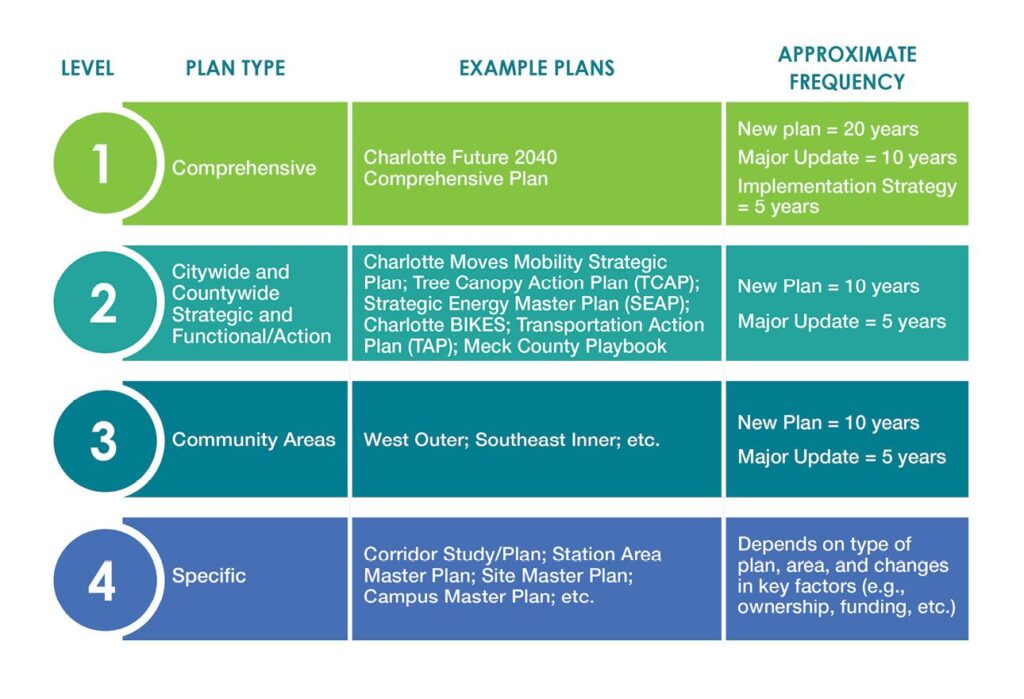Home / Implementation Strategy / 2 Planning Approach
Implementation Strategy
Table of contents
2 PLANNING APPROACH

The following describes a revised approach and hierarchy for aligning and guiding planning efforts in Charlotte. The Charlotte Future 2040 Comprehensive Plan is the guiding document that directs the City’s long-range development efforts and the other types of plans critical to realizing the community’s vision and goals. The intent of a new planning approach and revised hierarchy is to ensure that planning at all levels in Charlotte is completed in an efficient and effective manner with meaningful participation and buy-in from individual residents, neighborhoods, property owners, business owners, partner agencies, major institutions and other key stakeholders. The four planning levels are summarized and described below.

It should be noted that existing plans at levels 1, 2, 3 and 4 are not nullified upon adoption of the Comprehensive Plan. Current Community Plans, especially those completed within the last 10 years, should be used as inputs into Level 3: Community Area Plans and future Level 4: Specific Plans. The guidance established in adopted Future Place Type Mapping and Community Area Planning (described in more detail in the following section) will take priority over existing Community Plans and District Plans once completed. Community Area Plans will utilize existing neighborhood and area plans as a foundation and provide the platform through a coordinated planning effort for updated neighborhood level recommendations and priorities. Where conflicts occur between plans types, the direction within the Comprehensive Plan, as the overarching vision for the City, should take precedence.
Level 1: The Comprehensive Plan
The Comprehensive Plan is developed in collaboration with community members, departments across the City, elected and appointed officials, partner agencies, and other community and regional partners to provide the highest policy level guidance for future development and redevelopment, infrastructure improvements and other public investments, transportation and land use connections, and a host of factors contributing to quality of life, affordability, equity and sustainability.
Level 2: Citywide and Countywide Strategic and Functional/Action Plans
Citywide and Countywide Strategic and Functional/Action Plans direct specialized components of city and county planning such as transportation, economic development, parks and recreation, housing, natural resources and sustainability. Due to the shared governance between the City of Charlotte and Mecklenburg County for many service areas, it is important to align community-wide plans for both jurisdictions and ensure that they align with and support the vision, goals, policies, and place guidance in the Charlotte Future 2040 Comprehensive Plan and the guiding principles and strategies articulated in Livable Meck, the County’s road map for protecting and enriching our quality of life. Citywide and Countywide Plans typically come in two varieties, although variations exist and sometimes the two primary types of plans are combined. Strategic Plans build on the higher-level policy guidance and direction set in the Level 1 Comprehensive Plan and set more specific goals, objectives, policy direction and performance measures/metrics for a specific topic with consideration for the entire City or County. An example currently being developed is the Tree Canopy Action Plan. Functional/Action Plans are guided by the Comprehensive Plan and applicable Strategic Plans and identify and prioritize a particular type of community investment or service. These plans involve analysis and typically the definition, mapping and listing of specific projects. Most Functional/Action Plans also include phasing and funding strategies. An example is the City’s Bicycle Master Plan (Charlotte BIKES).
Level 3: Community Area Plans
Community Area Plans provide detailed strategies and recommendations regarding land use, built form, transportation, infrastructure, parks, recreation, open space, and facilities for sub-geographies of the City. The purpose of Community Area Plans is to engage and unite neighborhoods to plan their own communities within a framework that efficiently and effectively uses the resources available to ensure the entire City has neighborhood level input and guidance. More information on the recommended approach to Community Area Planning is provided in the next section.
Level 4: Specific Plans
Specific Plans address smaller scale geographies and are focused on implementation. They should be guided by higher order plans (Levels 1, 2 and 3 above), but generally focus on further conceptualizing, planning and sometimes designing a specific small geography. Thus, the Functional/Action Plans and Community Area Plans typically provide the relevant guidance and direction for a single large property, a grouping of properties, or a Place. Examples of these types of plans include transit station area master plans, area reinvestment plans, campus plans, and corridor plans.
